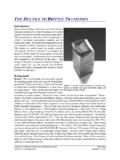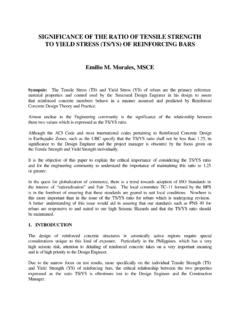Transcription of Plastic Deformation and the Onset of Tensile …
1 Department of Chemical Engineering and Materials ScienceMike MeierUniversity of California, DavisSeptember 13, 2004 Machine StiffnessPLASTIC Deformation AND THE Onset OFTENSILE INSTABILITYI ntroductionIn this experiment the Plastic Deformation behavior and the Onset of Plastic instability of somecommon structural alloys is investigated. The usual mechanical properties are measured from stress -strain curves, but in addition, strain hardening behavior and the Onset of Plastic instability arestudied. A lot is going on during a Tensile test, some having important practical uses and many alsohinting at the fundamental mechanisms of Deformation processes.
2 The goal of this experiment isto investigate all of Deformation When an isotropic material is loaded to stresses below the yield point and thenunloaded again all of the Deformation is immediately recovered. This behavior is usually associatedwith the linear portion of the stress -strain curve, although not all materials exhibit this linear-elasticbehavior, rubber for instance. But for many materials the resistance to Deformation in this regionis given by Young s modulus EWhen measuring Young s modulus one must take into account the stiffness of the testing , the machine would be perfectly stiff but in reality it may be in the neighborhood of 40,000to 100,000 pounds per inch.
3 This will introduce errors in the measured modulus which are given bywhere A0 is the initial cross-sectional area of the specimen, L0 is the initial gage length, E is thecorrect value of young s modulus and K is the stiffness of the testing machine. Without these corrections, the error in the measured modulus is mostly in measurement ofelongation. The specimen, being a monolithic part with no joints while the testing machine hasmany joints, moving parts that mesh better when loaded, etc., means the specimen is stiffer than thetesting machine. Consider also that the modulus is the ratio of stress , a large number, to strain, asmall number. The result is very sensitive to errors in the conducting a constant crosshead speed test one can compute the stiffness of the testingmachine using the equation0 100 200 300 400 500 Nominal stress , Nominal Strain 6061-T651 Aluminum Cold Rolled 1018 Steel Annealed 1018 Steel Copper C26000 Brass, half-hardFigure 1.
4 stress -strain curves for several common is the crosshead speed and is the loading rate. Or, one can use an extensometer tomeasure strain directly from the specimen. If, after the test, one compares this strain to thedisplacement of the crosshead one will notice small errors in the engineering strain : Materials scientists recognize that some Plastic Deformation is occurring prior to the yieldpoint and that elastic Deformation continues past the yield point. In other words, yielding does nothappen all at once at a single point on the stress -strain curve, as might be thought when consideringyielding from the continuum mechanics point of view.
5 A more practical definition of yielding iswhen Deformation changes from being mostly elastic to mostly Plastic . This definition seems tomake the method of measuring the yield strength somewhat arbitrary, which it is, but standardmethods have been defined so that everyone will get the same result. In fact, there are a number ofstandard methods one may use and the method used varies depending on the type of yieldingbehavior (sudden, gradual, upper/lower), industry, or country. In any case, the significance of theyield point is that prior to yielding most of the Deformation was recoverable elastic Deformation andafter yielding most of the additional Deformation is permanent, Plastic Deformation .
6 Strain Hardening: Plastic Deformation can occur by three different processes: diffusion, twinningand dislocation motion. The contribution of diffusional processes is important at high homologoustemperatures, T > Tmp. Twinning might account for up to a few per cent strain while dislocationprocesses are generally the principle mechanisms for Plastic Deformation . Considering only the contribution of dislocations, the shear stress acting on the slip plane causesthese dislocations to move through the lattice. As they move they may encounter obstacles such assolute atoms, particles, grain boundaries and other dislocations, effectively stopping the dislocationuntil the stress is increased and the dislocation can overcome the obstacle.
7 While this dislocationwas gliding, climbing and cross-slipping through the lattice additional dislocations were beingHollomon EquationLudwik's EquationRate of Strain HardeningDorn EquationStrain Hardening Indexgenerated and they were moving through the lattice. With this ever increasing dislocation densitythe distance between them decreases, they encounter each other more often, and it becomesincreasingly difficult to deform the material. This process is called strain hardening. There are two well known equations that depict the strain hardening phenomenon. The Hollomonequation describes strain hardening as a power law function of stress and strain after yieldingwhere F and , are stress and strain beyond the yield point.
8 The second equation is Ludwik'sequation. It is often preferred because it includes the stress up to the yield point, not just the stressproduced by strain both of the above equations K is the strength index, n is the strain hardening index, and Fo is theyield stress . The strength index K is structure dependent and varies with processing. The strainhardening index is a constant for a given material and can range from 0 to 1 but is typically in therange of to In cases where the material has already experienced some Plastic deformationthe following equation represents strain hardeningThe strain hardening index can be written asand it can evaluated numerically or graphically from the slope of a plot of log(F) -vs- log(,).
9 Thisequation also expresses strain hardening in terms of the rate of increase of stress with respect tostrain. Rewriting it giveswhich says that the rate of strain hardening is proportional to the stress divided by Rate Hardening: Most materials are sensitive to the rate of Deformation . This behavioroften obeys a power law expression such aswhere A is a constant at given temperature and metallurgical condition and m is the strain ratesensitivity. This equation can be combined with the Hollomon equation for a general descriptionof the Plastic Deformation of 200 400 600 800 1000 True stress , Nominal StrainFigure 2. Consid re s construction for determining the Tensile strength of a ductile material.
10 The Tensile strength isfound at the intersection of the straight line and the stress axis at strain=0. [2] Tensile StrengthAt low and ambient temperatures the rate of strain hardening is significant, <n< , while the ratesensitivity is small, <m< At higher temperatures just the opposite is true and the strainrate sensitivity can reach values as high as (Newtonian viscosity) while the strain hardeningindex can approach the strain rate sensitivity can effect the flow stress it is more important in terms of its effecton ductility. While increased strain rate sensitivity slightly increases the strain at which the materialstarts to neck, it can extend ductility considerably by stabilizing the neck.






